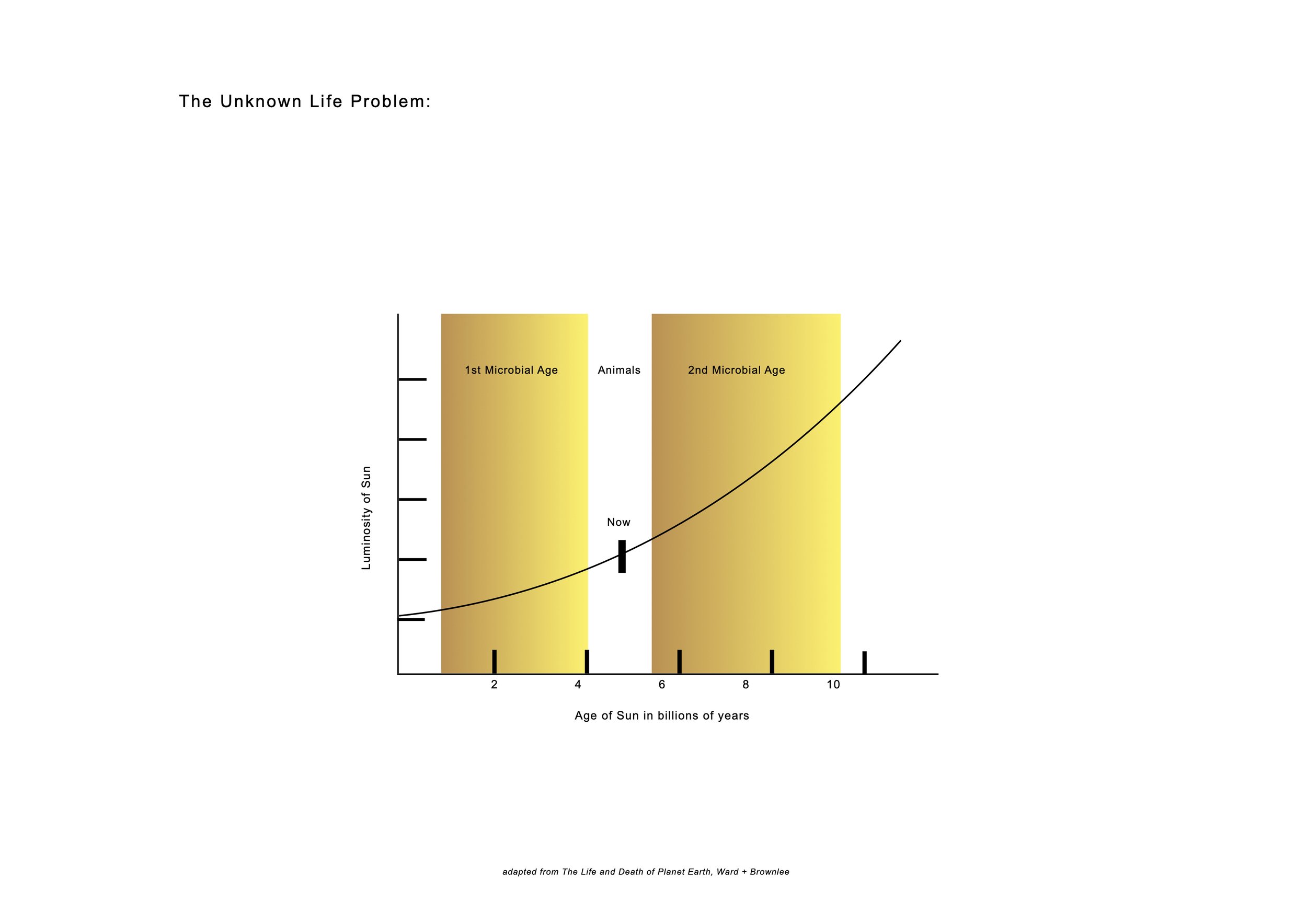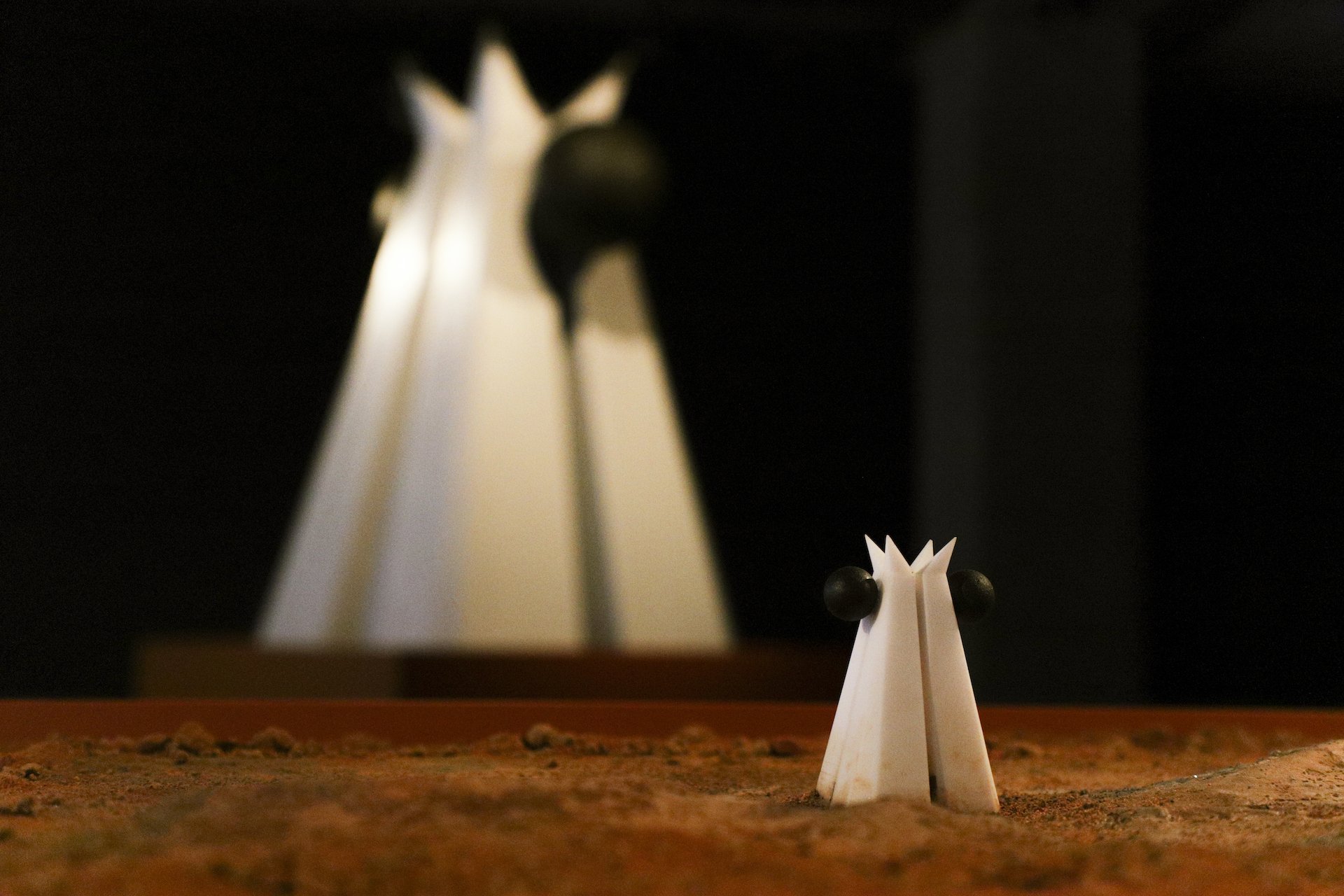2.8B420K
a monument to the end of all life
The project 2.8B420K is both a conceptual thought experiment and a genuine architectural proposition.
In 2.8 billion years time, the increased luminosity of the expanding Sun will cause the Earth's average temperature to reach 420K (147C). At this temperature the final vestiges of life, simple sub-terrestrial microbes taking refuge at the poles, will become extinct, marking the planet’s transition from biological to post-biological. This hugely significant moment in Earth’s history will pass by unnoticed.
The project 2.8B420K proposes the design and implementation of a monument (also known as The Object) that, by triggering a material malfunction at 420K, will make a performative gesture to commemorate this transition. No living thing will witness this performance. The Monument performs to itself, to the lifeless Earth and to the wider Universe.
The proposal for the project 2.8B420K is complicated and probably impossible. At best it is faced with a complex web of virtually insurmountable obstacles, challenges and unknowns ranging from geology and climate to anthropology and material science. The timescales involved make empirical knowledge and decisions impossible. The critical moment lies in the deep future where speculation reigns over certainty. Over such deep timelines the Earth's surface is fluid and the forces of climate and erosion inexorably change and erase everything. We have already seen many such changes in the geological record. We don’t know how long humanity has left, or how it would adopt or maintain such an object. No material as ever been tested over such timescales.
However, through combining both traditional and speculative threads of inquiry into geology, anthropology, material sciences, climatology, architecture and design, it is possible to attempt to get close to making the impossible possible. While there is a strong narrative in the combined threads of research, the project also generates speculative ideas that create a strong fictional counterpoint. By combining these fictions and nonfictions, the project becomes a rich and complex case study for how we consider the ends of all things on Earth and offers an opportunity to cast ourselves into a post-human future.
The Monument, and the idea of the Monument - a synecdoche for something much larger than itself, anchor a thread in the present that stretches into the deepest future of life, over unknown cycles of change in what the planet actually is.
The Monument, also known and described as ‘The Object’, is sited in the location best equipped to protect it geologically during the next 2.8 billion years. Accepted as a globally important and ’post-scarcity’ project, it has been built with the most resilient materials known to humanity and sited within a geologically protective sarcophagus. The Object sits deep underground and waits beneath a protective mountain.
Over hundreds of millions of years, while continents shift and reconfigure, the protection is slowly eroded and weathered away. It is hot and the Earth is quiet. No creatures roam the surface or swim what is left of the seas.
After a billion years, the mountain that protects The Object is gone, as are all mountains, all continents that were known in the time of humans. The Object now sits beneath its diamond dome. As it in turn slowly weathers away, the fierce sunlight penetrates and touches the surface of The Object for the first time. Deep into the future, it is released into a vastly different world. A world that is mostly desert, devoid of all animal and plant life, where only microbes remain. The world is hot, and slowly getting hotter. The Object waits, its own inherent strength and resistance protecting it over further tens of millions of years.
Eventually, some 2.8 billion years from now, the average global temperature reaches 147 Celsius, the temperature at which all life ends. At this same temperature, a material component reacts within The Object, deforming and melting. This material failure triggers the action. The action is a performance that commemorates the end of all life on Earth. A simple and final gesture to mark the transition.
PAGES FROM THE 2.8B420K ARCHIVE AND ARCHITECTURAL PROPOSAL
a digital download of the 2.8B420K archive is available by following this link
—- -
When I was a small child, I had a recurring vision. But it wasn’t really a vision. Nor was it a hallucination or a dream. It was a lucid and crushingly tangible awareness of something terrible and horrifying. It would leave me rigid with foreboding. I would suddenly become aware of the presence of two huge and massive spheres, incalculably heavy and immeasurably ancient. The spheres were connected by a thread finer than a human hair, finer even than gossamer - and they were moving apart, at sub-tectonic pace. The thread holding them together was, micron by micron, bearing more and more tension. If this thread were to break, and the spheres were to become separated, it would mean the unleashing of all the darkest horrors that humanity, its underworlds, nightmares and meta-realities could possibly imagine.
- --
The Object’s task is to hold these spheres for 2.8 billion years. When all life ends then the spheres will finally separate and fall. All the darkest horrors can become unleashed, but nothing will exist to suffer them.
INSTALLATION VIEWS
all exhibition images by Marijo Zupanov
a special edition of SUM Journal - ŠUM #19 ‘Models of Extinction’ - was published featuring theoretical and speculative fiction texts based on the 2.8B420K idea.
2.8B420K was developed with the wonderful support of Projekt Atol and was premiered at Osmo/za
conceptual development and research assistance from:
Matthew Wolf Meyer, Blaz Vicic, Rok Brajkovic, Beti Zerovc, Nuria Lorca Isern, Martin von Kranendonk














